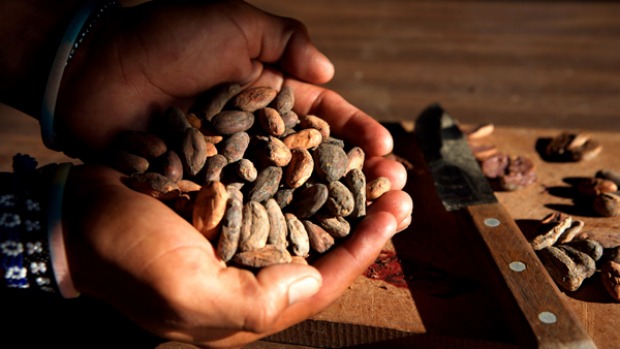
The cocoa bean's story embraces Mayan culture and a growing fair-trade movement, writes Sue White.
Climbing into the twin-propeller plane in Belize City, I'm reminded that this tiny country wedged between Mexico and Guatemala is indeed off the beaten track. Sure, the Tropic Air flight seats about a dozen but none of us can stand up.
During our hour-long journey to southern Belize, the aircraft acts more like a bus as we stop along the way, dropping off passengers, mail and bank deposits to villages on the Caribbean coast.
Despite a bird's-eye view of the sparkling sea and coral reefs that most visitors to Belize come for, my gaze is drawn to the land. Our low altitude affords an unparalleled view of the region, a thick, tropical jungle, home to myriad small farmers growing some of the world's finest cocoa.
Although Punta Gorda seems no less sleepy than the small towns my plane diverted to, it's the capital of Belize's Toledo District.
But in the mind of many visitors, it's the capital of chocolate, or at least its key ingredient, cocoa.
The community of Punta Gorda is realising visitors want a taste of something more than coastal life; they want to trace chocolate to its roots and through the production process.
For example, some fans of the premium organic chocolate Green & Black's - a niche brand in Australia but a household name in Britain - tracked the fair-trade product to the 900 or so farms around Punta Gorda as part of their travels.
The Toledo Cocoa Growers Association (TCGA) has spent the past 16 years quietly building a successful partnership with Green & Black's; as a result, the organic cocoa beans from the small-scale, co-operative farms end up on our shelves in the fair-trade chocolate, Maya Gold.
While chocolate tourism may be new, the local connection with cocoa is age-old. Mayans valued the cocoa bean (known as cacao) for its supposed links to fertility; chocolate drinks, called kukuh, have been used on ceremonial occasions in this part of the world for at least 1500 years.
Chocolate begins its lifecycle in the heart of the cocoa pod. Sprouting from attractive, shady trees, the large, oval-shaped cocoa pods are harvested at peak ripeness. Farmers dig out the four dozen or so beans lying under the sweet, pulpy flesh inside the pod and begin the drying and fermenting process. After up to a week lying in the sun, the beans turn from purple to almost brown.
When local tourism operators realised the depth of visitors' interest in their farmers' crops, a small side industry in tours began. Year-round, visitors to Punta Gorda can head out on the cocoa trail for a three-hour tour that includes visits to organic farms and lunch in one of the farmer's simple homes. If you're patient enough to wait until the Punta Gorda tourist office is open (it can be hit and miss), you may also be able to arrange for a homestay on a remote farm (highly recommended).
The formal tour operators are nowhere in sight but I'm lucky enough to be in the hands of local TCGA manager, Armando Choco. We leave Punta Gorda early to head for the hills where the heart of cocoa country lies. Farms are well disguised among the lush green jungle and as we trek our way up and down a rough trail, Choco shares his understanding about the difficulties farmers face: "My grandparents farmed and I saw their struggle," he says.
"My father fell ill when I was young, so he couldn't teach me what he knew but I knew what they went through and what the rewards were when they sold their product."
I puff my way along under 100-year-old cocoa trees towards Luciano Sho's farm, arriving hot and satisfyingly dirty. It's worth the hike to hear Sho explain that his fair-trade pay packet has made a real difference for his children's education.
"I wanted to make sure my children were not as foolish as me," he says of his education. "I have 13 children; one is a teacher, one is in the air force and another is at technical college."
While getting out to the farms is rewarding, there's an even easier way to absorb the district's connection to chocolate. Each May, Punta Gorda hosts the colourful Toledo Cacao Festival, a three-day celebration of cocoa, chocolate and Mayan culture.
Locals also produce their own but don't expect the local bars to taste the same as what you find on Western supermarket shelves: the sweet magic of a good chocolate bar as we know it comes later in the production process. Instead, I make do with the kukuh drink, a sweetened, earthy concoction that farmers cook up for their visitors.
Sipping the traditional drink, deep in the heart of the jungle, is so satisfying that I could stay indefinitely, especially if it meant escaping the nerve-racking flight out of here.
The writer travelled courtesy of Green & Black's.
TRIP NOTES
Getting there
Fares from Sydney to Miami via Los Angeles and Denver start at $1600 plus taxes, depending on the airline. Phone 1300 767 757, see bestflights.com.au.
Flights from Miami to Belize City start at $US800 ($1245) return on American Airlines. Tropic Air's flight from Belize City to Punta Gorda starts from $US102 one way.
Staying there
Hickatee Cottages has Caribbean-style cabins in a jungle setting from $US75 a double. See hickatee.com. Beya Suites is within walking distance of the town centre, from $US60 a double. See www.beyasuites.com.
Touring there
Cocoa farm tours can be organised in person via the Toledo Travel Centre in Punta Gorda town or through IBTM Tours (email: [email protected]). Costs start from $US51 for a three-hour farm tour.
The Toledo Cacao Festival is held on May 22-24 and will feature cooking demonstrations of kukuh, music, dance and tours. See toledochocolate.com/.